1960 Belgian Grand Prix race report: Brabham wins tragic race
Jack Brabham comes home first in race marred by deaths of Alan Stacey and Chris Bristow
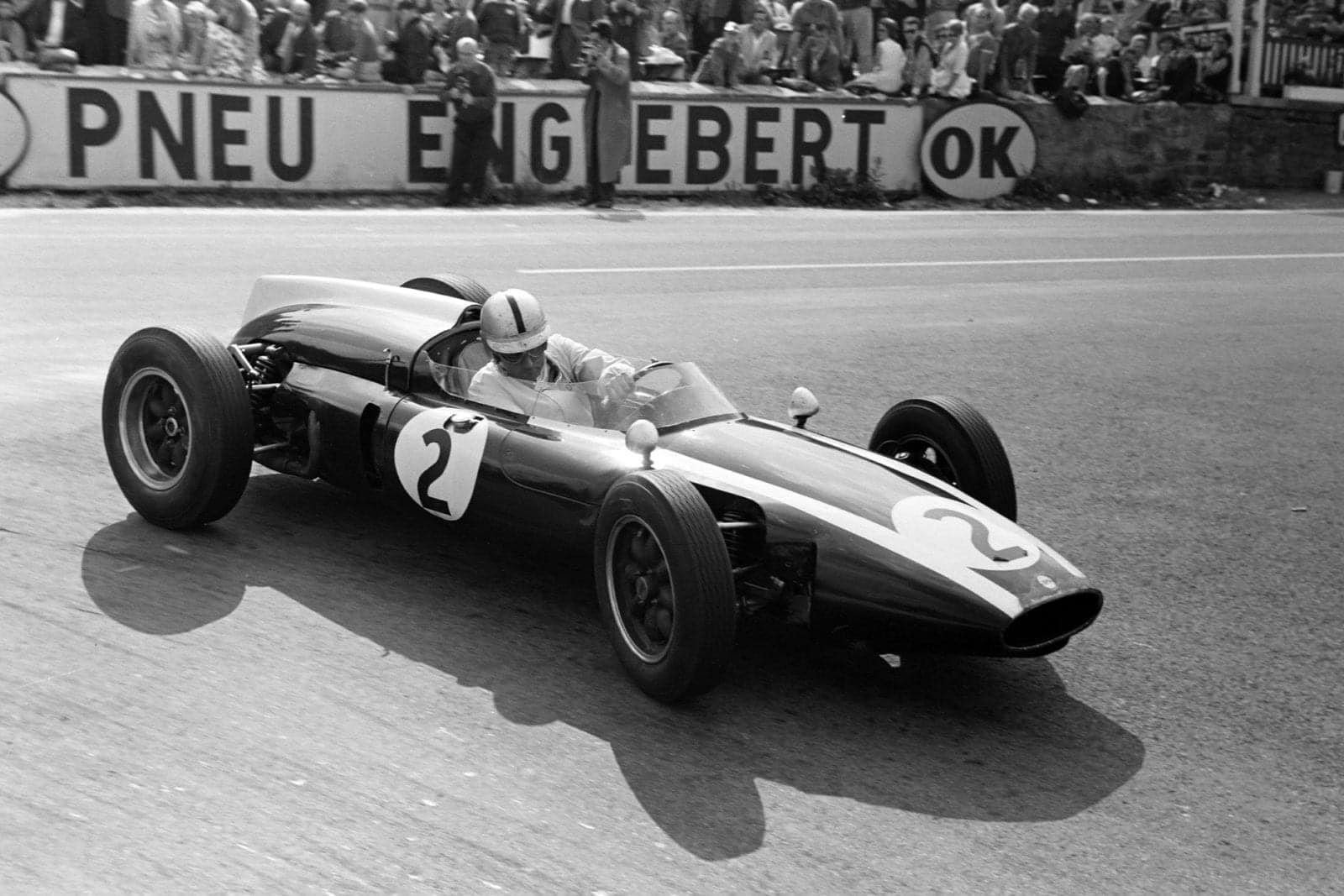
Cooper's Jack Brabham on his way to a second consecutive victory
Motorsport Images
When the Belgian Grand Prix was last run, in 1958, the organisers slipped up in their estimation of the performance of the competing cars by holding the race over 300 kilometres on the superfast Spa-Francorchamps circuit. The reality was that the event was all over in 1hr 37min for the average speed of the winner was nearly 130 mph and as an important Grand Prix it was rather ludicrous. Due to to financial wrangles there was no Belgian Grand Prix in 1959 but this year the magnificent 14.1 kilometre circuit in the Fagnes mountains, not the Ardennes as is popularly supposed, once more rang to the sound of Grand Prix car racing round the hills and in order to be sure of not repeating the 1958 mistake the Royal Automobile Club of Belgium made the race over 500 kilometres.
With lap speeds of well over 130mph this ensured that, the race would go on for a reasonable length of time, and also introduced a welcome return to Grand Prix racing of a long and arduous nature rather than some of the sprint-type events that have happened, thus endeavouring to put Grand Prix racing on a higher plane than most other types of motor racing.
Qualifying
Practice began on Friday afternoon and early evening, from 5:30pm until 8pm so chosen to avoid disrupting local traffic unduly for this high speed circuit is still part of the normal road system of the district, even if many of the corners are super-elevated. Twenty cars had been invited, of which the fastest sixteen in practice were to qualify for the starting grid, but at the last moment the lone Vanwall was withdrawn so practice saw nineteen competitors turn out promptly.
Notable absentees were Aston Martin, who were not interested in entering on this fast circuit and the Scuderia Centro-Sud who wanted to enter but were turned down by the organisers, so in consequence the list of drivers lacked the names of Salvadori, Trintignant and Gregory; a strange situation considering they were all seasoned Grand Prix drivers. Instead there were Michael Taylor, Mairesse and Bianchi making their first appearance in a serious motor race.

Mairesse put his Ferrari 12th on the grid
Motorsport Images
Apart from this all the regular runners were present. Brabham and McLaren with the two works Coopers; Bonnier, Gurney and Graham Hill with rear engined BRMs, the three cars arriving in a brand new transporter built on a Leyland Royal Tiger chassis, and making a very handsome addition to the paddock transport park. Gurney had his left fore-arm in plaster, with cracked bones following his Zandvoort crash, but able to drive in spite of this.
Moss was once more in the dark blue Lotus of the Walker Team, the car now sporting a long air-duct from the nose of the car, along the side of the cockpit to the two large double-choke Weber carburetters, rather like that used on the Yeoman Credit Coopers. Michael Taylor was also driving a private rear-engined Lotus, entered by Taylor and Crawley, and Ireland, Stacey and Jim Clark were driving the works rear-engined Lotus cars.
The Scuderia Ferrari had three front engined all-independently sprung Dino 246 cars, driven by Phil Hill, von Trips and the Belgian driver Mairesse, and the two Scarabs were driven as usual by Reventlow and Daigh. Fred Tuck had entered his 1959 works Cooper with Lucien Bianchi as driver and to complete the list were the three Yeoman Credit Coopers for Brooks, Bristow and Gendebien, while they also had their 2-litre Cooper as a practice car. Gendebien’s car had a brand new engine as the reported seizure on Bristow’s car at Zandvoort had turned out to be a broken big-end bolt with the result that the con-rod came out through the side of the crankcase and wrote off the engine.
“Many of the drivers had never raced at Spa before”
The last time the Spa circuit had been used by Grand Prix cars, in 1958, Hawthorn had made fastest practice lap in 3min 57.1sec, and in the race he had set the official lap record at 3min 58.3sec, a speed of 213.068 kph (approx 132mph), so that with two years’ development on tyres, road-holding and power outputs, some incredible speeds were expected.
Many of the drivers had either never raced at Spa before or had only driven round it in sports car races or not-so-powerful Grand Prix cars, and Brabham and McLaren circulated in close company learning the way round, while Yeoman Credit sent Bristow out in the 2-litre car as it was his first visit. Brooks, however, was going very fast from the beginning, this being his favourite circuit, he really enjoying the high speed cornering. Phil Hill and his English namesake two more drivers who were in their element on the high speed cornering, which means any thing up to 160mph while Stacey and Clark were having to face up to reality for the first time in a Formula 1 car.
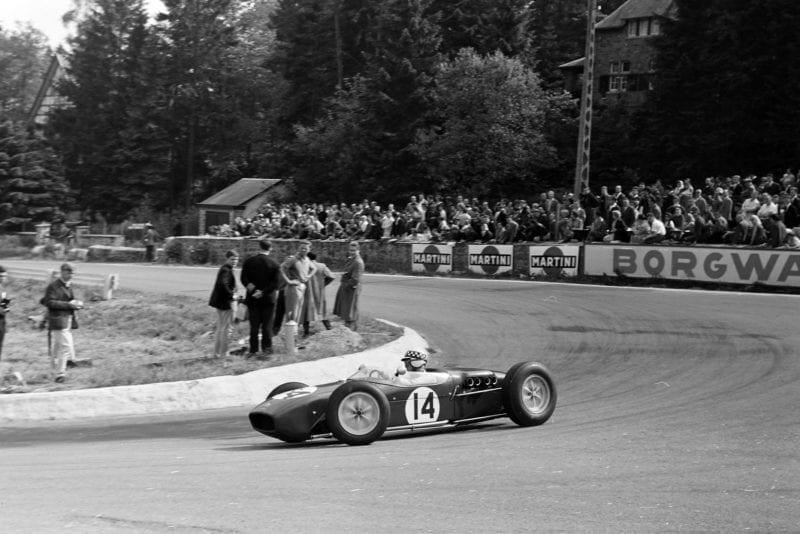
Innes Ireland qualified his Lotus in 7th
Motorsport Images
The Scarab team were new set an entirely different problem, after the stopping and starting of Monte Carlo, and the medium speed swervery of Zandvoort and Moss was more interested in super-tuning the Walker Lotus over and above those of Chapman, the circuit having no problems for him.
Brooks was very soon below the old record, as was Moss, but Brabham was learning his way round at about 4 minutes, until near the end of practice be showed how well he had learnt by going round in 3min 50.0sec a full 2½ seconds faster than Brooks, representing a lap speed of 220.695kph (approx 137mph) the new Cooper chassis now obviously being well suited to the, high speeds, was only one-tenth of a second slower than Brooks, and Gendebien had been driving beautifully to record 3min 53.5sec and fourth best time.
The Ferrari of von Trips was giving trouble so he took the Mairesse car and recorded 3min 58.9sec while Phil Hill could not approach 4 minutes, which did not say much for Ferrari development over the last two years.
After learning the way round on the training car Bristow went out in his Formula 1 car and though having to put a lot of physical effort and concentration into his driving, he made the very creditable time, of 3min 56.9sec.
Ireland recorded a best time of 3min 55.4sec even though the Lotus was not getting maximum revs on the straight: and then he suffered from a slipping clutch, so borrowed Clark’s car, and Stacey was also in trouble, his car shearing a bolt in the steering.
While it had been certain that the old lap record would be improved upon it had not been expected that Brabham would have knocked so many seconds off, being a full 7 seconds faster than the best time in 1958 and with an average speed for the lap of 137mph. It was interesting that maximum speeds this year, on the downhill Masta straight, were not outstandingly high, being little more than 170mph and yet the average speed of the lap had gone, up by 5mph. This was undoubtedly accounted for by improved cornering power due to 2 years of tyre development and better acceleration in the 120-160mph range due to improved torque characteristics of the Climax engine rather than any great increase in total bhp.
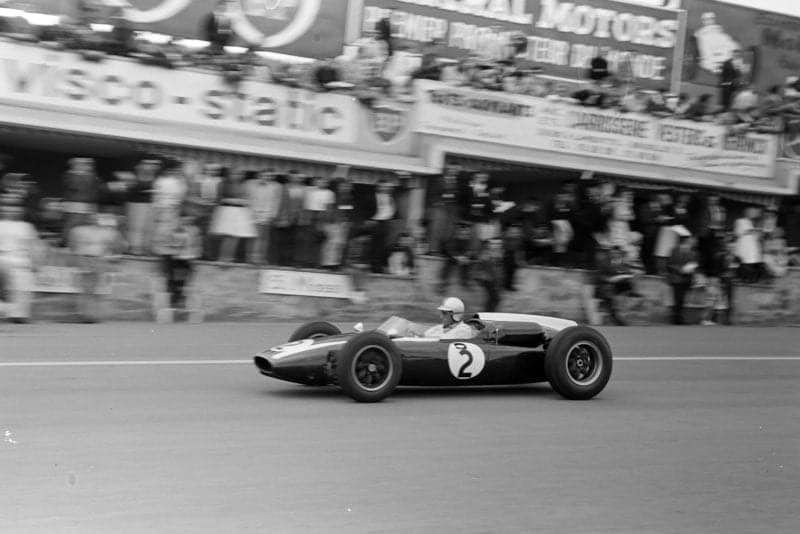
Brabham scored a pole for Cooper
Motorsport Images
On Saturday afternoon the sun was shining, so much so that the tar at La Source hairpin was beginning to melt. This was the last opportunity for drivers to improve their positions on the starting grid and once more all nineteen cars were ready for practice. Things were just beginning to get warmed when news came through that Moss had crashed in the Walker Lotus and then everything came to a very sudden halt. Most of the drivers who were circulating at the time stopped at the scene of the accident and as each one eventually returned to the pits various accounts of what had happened were given. The main point of agreement was that Moss was not seriously injured and he had gone off the road at the end of the fast downhill right hand bend at Burnenville.
Just before this happened Bristow had stopped out on the circuit when his gearbox broke on his Yeoman Credit Cooper and almost at the same time as Moss had crashed Michael Taylor had crashed on La Carriere bend on the return leg of the circuit, so that with a rear engined Lotus crashed on each side of the circuit there was some confusion amongst the stories that arrived back at the pits.
For a very long while all activity on the circuit ceased and the packed grandstands were strangely silent while the public awaited confirmation of what had happened, while in the pits there was an air of depression and no great interest in any further practising. Eventually the details of what had happened could be pieced together and some semblance of the truth could be formed.
“Moss had his left rear stub axle break and the wheel parted company from the car…this happened just as he was taking a bump at the exit of the curve”
On the Burnenville corner which is taken at over 130mph in one long curve that goes round for some 150 degrees in a wide sweep down the side of a valley, Moss had his left rear stub axle break and the wheel parted company from the car. This happened just as he was taking a bump at the exit of the curve, where Coopers and Ferrari were literally being deflected as much as two feet sideways and the Lotus and BRM were riding well, but making their suspension work overtime. With most of the weight of the car being on the outside rear wheel it can easily be imagined what happened when the stub sheared. The car spun, hit the bank on the outside of the bend, threw Moss out and bounced across the road to land a mangled wreck on the inside of the corner.
On being taken to hospital Moss was reported to have a broken nose and back injuries and the buzz of relief amongst the public when this was announced over the loudspeakers was remarkable. Later it transpired that he had also cracked bones in both his legs, but they were not serious. While all this was going on poor Michael Taylor was taking the fast right hand bend at La Carriere on the uphill return leg of the circuit, when his steering column broke and in a flash he had gone he had gone straight on, over some small bushes and into the trees, being extremely lucky to get away with broken ribs, collar bone and a neck injury.
With two accidents happening almost simultaneously the organisation was thrown into confusion end it was an extremely long time before the circuit was re-opened for practice, during which time the Walker van set off to collect their wreckage, various drivers went round to the scenes of the accidents and Colin Chapman took Ireland’s car and went on a tour of inspection.
When practice resumed the Lotus works team packed up and went home, the Ferrari team got down to some serious efforts to put up a show and Brooks had a try at doing some fast laps. Phil Hill was working hard with the Ferrari and got down to an excellent 3min 53.5sec and von Trips did 3min 57.8sec. Brooks did not improve on his time, the wet tar at La Source and a certain amount of dust on the road at Burnenville making things difficult.
The Scarabs were still not fast enough and were lapping at around 4min 28sec, which made the time of 4min 09.7sec, of yesterday a bit suspect, and Paul Frere tried one of the cars and recorded 4min 23sec. At 5pm practice finished, even though there had been something like 1½ hours lost due to the confusion, and it could not be extended due to the circuit being on public roads and traffic having to go about its daily business. Even so, there did not seem to be any great enthusiasm for going on any longer for the double-accident had rather taken the edge off the general air of enthusiasm.
Race
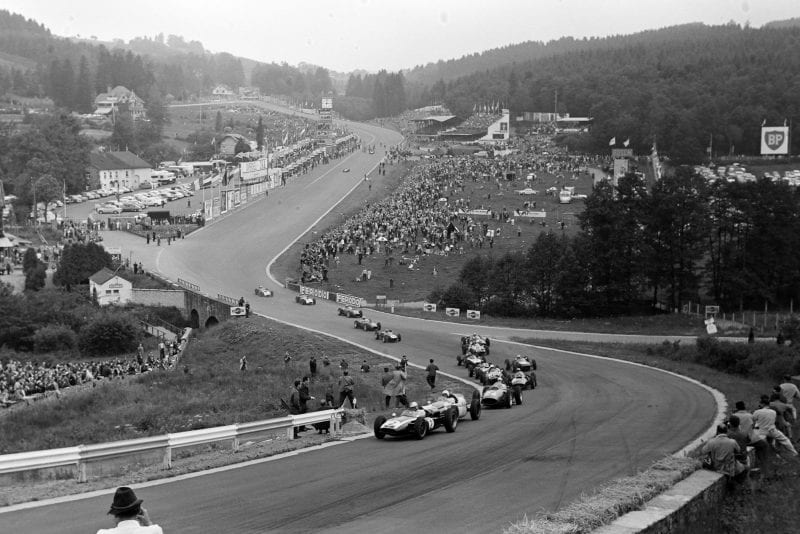
Brabham heads the field at the start
Motorsport Images
Sunday was cloudy and overcast as the cars assembled at the pits but by the time the drivers had been paraded round the circuit in open ‘sporty’ cars the sun was shining and the mists had cleared. With Moss and Taylor unable to start, the organisers allowed the remaining seventeen cars to start assembling on the grid, with the two Scarabs making their first European race appearance, as distinct from practice.
“Usually the opening laps on a long circuit such as Spa sees the field spread out into groups, but this time all seventeen cars were nose-to-tail”
The organisers were a bit late in getting the cars assembled so that the start was given rather hurriedly, so hurriedly in fact, that Clark’s car was still being put into position by the mechanics when everyone rushed off and in the confusion Bianchi stalled his engine while trying not to run over the Lotus mechanics.
The front of the grid got away well and as the cars went streaming up l’Eau Rouge hill Gendebien was virtually pressing on Brabham’s tail and Phil Hill’s Ferrari was close behind. Usually the opening laps on a long circuit such as Spa sees the field spread out into groups, but this time all seventeen cars were nose-to-tail, Brabham leading and Reventlow bringing up the rear.
On the second lap Ireland got past Phil Hill and the first seven cars arrived back at La Source hairpin in a tight group, storming down the hill past the pits in the order Brabham, Ireland, Phil Hill, Bonnier, Gendebien, Graham Hill and McLaren, as quick as that. Then a short gap and Brooks, Bristow, von Trips and Mairesse went through in follow-my-leader order and Gurney, Bianchi, Stacey and Clark went by with Daigh in last place, already getting left behind.
The other Scarab had stopped very suddenly out on the circuit when a connecting rod broke and came out of the crankcase in a cloud of smoke. Lap 3 and the bunch at the front of the field were just as close, but Bristow came by in eighth place on his own, followed by the Ferraris of von Trips and Mairesse and then Brooks arrived slowly at his pit and retired with a broken gearbox.
On the next lap Phil Hill stormed past Ireland and Gendebien and McLaren got past Bonnier and the whole bunch were still so tight that though Brabham was credited with a new lap record in 3min 53.5sec, they must all have been within tenths of seconds of this. Phil Hill was really making a race and getting up alongside Brabham down the Mesta straight so that after five laps there was the suspicion of a gap appearing between these two and the other five cars in the leading group which were following in the order Ireland, Graham Hill, McLaren, Gendebien and Bonnier.
Meanwhile, von Trips had passed Bristow and Clark was making up for his bad start and closing up on Stacey and Bianchi, while poor Daigh was way back on his own. Gurney dropped out when water came out of his exhaust pipe, indicating internal trouble in the engine and at the end of lap 6 Ireland stopped at his pit to complain of clutch slip; the limit-stop for the hydraulic operating unit was removed and he rejoined the race, but so hot was the overall pace that he was now way down at the back of the field, though still in front of the lonely Scarab.
With the sun shining and the roads dry the race average was over 215kph (133mph) which was well above the record lap of two years ago and one felt that Phil Hill was making the pace, for at 10 laps he was only seconds behind Brabham, and causing the works Cooper driver to keep looking over his shoulder, for though he had pushed the lap record to 3min 52.9sec-218.887kph.
Hill was lapping within a fraction of a second of this time, and the two of them were 12 seconds ahead of the third man, which could have been McLaren, Graham Hill, Gendebien or Bonnier, for these four were still having a splendid battle, McLaren leading on lap 8, Hill on laps 9 and 10 and Gendebien on lap 11. They were lapping at around 3min 53sec and when the Cooper pit signalled this to McLaren the young New Zealander thought “oops! that’s too fast, I’m getting out of my depth” and wisely eased off a bit and dropped to the rear of the quartet.
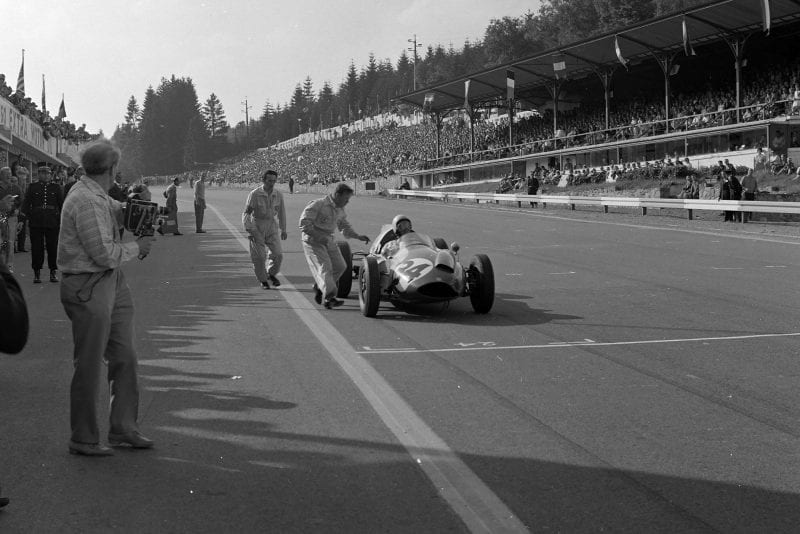
Gendebien in the Cooper pits
Motorsport Images
Behind them von Trips and Bristow were having a ” ding-dong,” the Yeoman Credit driver nipping into the lead at the hairpin only to have the Ferrari roar past him as they went by the pits. Further back Ireland had caught his two team mates and when he went by Clark tucked in behind and kept up with the Lotus leader, while Stacey did not try to match Ireland’s pace.
On lap 11 Brabham lapped the Scarab and just as the rest caught it Daigh pulled into the pits with an oil leak from the exhaust cambox. Two laps later, while Daigh’s Scarab was still there the pits became a hive of activity, for Bonnier missed a gear change and sent the revs sky-high and stopped to see if he had wrecked the engine, Ireland was back in again and Bianchi came slowly down the hill with a broken inboard universal joint on the right hand drive shaft of Tuck’s Cooper. Bonnier was sent off with his fingers crossed, hoping the engine was all right, but it was not, for two laps later there was a big bang and he stopped out on the circuit.
Bianchi and his mechanic set-to to fit a new drive shaft and Ireland restarted after a lengthy stop only to have a violent spin on the slowish left hand bend at Blanchimont which revolved him five times in quick succession and then just when he thought he had the Lotus under control it dived off the road and down a bank, bending the car but not the driver. Clark also spent some time at the pits on lap 14 to have his carburetter jets blown through, so that Stacey was the only member of the Lotus team still in the running, but he was a long way behind Mairesse, in 9th place.
At 15 laps Brabham had managed to struggle a 12 second lead over Phil Hill, but the Ferrari was going as well as ever, though Gendebien, Graham Hill and McLaren were beginning to close up on the Ferrari. Behind them Bristow had scrabbled past von Trips once more at the hairpin and managed to stay in front, but Mairesse was beginning to get the hang of this Grand Prix racing and was closing up on them, and when von Trips lost the use of his clutch the Belgian driver got by and set off after Bristow.
At half distance, 250 kilometres or 18 laps, Brabham still led but now only 9 seconds in front of the Ferrari for Phil Hill was getting his second wind and having another go, especially as Gendebien, Graham Hill and McLaren were now nose-to-tail just behind him. At 50 seconds behind Brabham came Mairesse with Bristow trying all he knew to hold on to the Ferrari, while von Trips had dropped well back as he could feel an unhappy vibration corning from his gearbox unit.
All on his own and the last car on the same lap as the leader came Stacey, not trying any heroics, but merely doing his best with a not very rosy situation for the Lotus Team. Clark was now a lap behind, and five laps behind Daigh was making sporadic circuits, the Scarab engine boiling, one of the fuel injectors leaking and altogether a sad sight. He eventually gave up for good on his 16th lap, giving Bonnier a lift back from his stricken BRM. Mairesse and Bristow were now engaged in a pretty lethal duel, two drivers who hardly knew each other and neither prepared to give any quarter.
“Bristow got on the wrong line, found himself on the outside of the bend at the wrong point and in trying to get back on to the inside of the bend he lost control and went off the road”
On lap 19 as they came down from the hairpin Bristow scratched by on the outside of the curve and just managed to lead the Ferrari over the line, and they rushed down to the swoop at l’Eau Rouge within inches of one another. Up the hill they went and into the woods, the pale green Cooper still leading, but as they went down the hill on the other side and into the long fast Burnenville corner, where Moss had crashed the day before, Bristow got on the wrong line, found himself on the outside of the bend at the wrong point and in trying to get back on to the inside of the bend he lost control and went off the road, being flung out and killed instantly, while the car careered off into the fields to finish up a crumpled wreck. Mairesse was lucky to miss the Cooper and its unfortunate young driver, and finished lap 20 on his own, signalling the bad news to the pits as he went by.
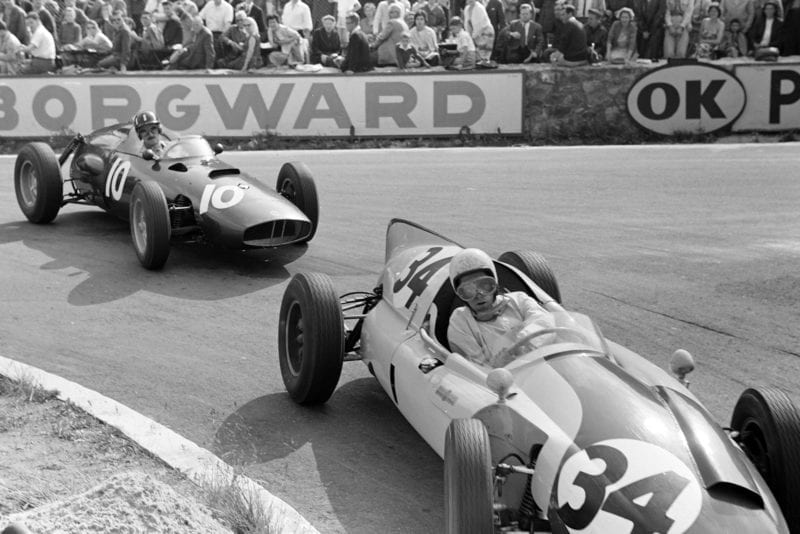
Hill, seen here dicing with Gendbien, ran as high as 3rd before retiring
Motorsport Images
Meanwhile Phil Hill was drawing away from Gendebien and his two followers, but Brabham was putting on speed as well and keeping the Ferrari at 8 seconds, while Bianchi now rejoined the race, having completed the fitting of the new drive shaft. As Phil Hill completed his 23rd lap he was 8 seconds behind Brabham’s Cooper and 8 seconds in front of Graham Hill’s BRM which was now leading the little dice for 3rd place. The Ferrari pit staff gave him a happy little signal which simply said “Bravo” but at this point von Trips got sideways-on near Stavelot when the noise in his transmision resulted in a broken drive-shaft and he skidded to a stop. On the very next lap Mairesse was missing and Stacey went by, now in 6th place and all on his own, still on the same lap as Brabham and the only other runners were Clark and Bianchi both going steadily but with no hope other than to finish.
On his 25th lap Stacey lost control of his Lotus for no very obvious reason, as he took the fast Malmedy curve, got on to the grass on the outside of the curve, hit a bank and went end over end across the road, over the right hand bank and down the hillside, the Lotus catching fire and being burnt out completely. As with Bristow’s crash the driver was flung out and killed instantly.
While awaiting news of Stacey’s disappearance, Mairesse arrived slowly into the pits with his transmission broken somewhere between the engine and the gearbox/differential unit, and at the same time Gendebien had chopped his way in front of Graham Hill once more, and McLaren was beginning to drop back a little.
On lap 29 the Ferrari pit were nearly in tears when it was reported that Phil Hill had stopped out on the circuit, and Brabham went by the pits now with 18 seconds lead over the BRM of Graham Hill who had once more turned the tables on Gendebien.
Phil Hill’s Ferrari had broken the tiny capillary tube to the fuel pressure gauge and the cold petrol on his leg had made him stop to investigate and he then found that the little jet of petrol had caught fire. He got this out and managed to restart and get back to the pits, where a stop of 1min 38sec allowed his mechanics to fix the broken pipe, but by now Brabham had lapped him so all he could do was to rejoin the race in 5th place and finish.
Brabham now had the race in his pocket, having led from the fall of the flag, and was able to ease up slightly, while Graham Hill was now 2nd and was drawing away from Gendebien who was in trouble with his gearbox. As Brabham went by the pits to start his 36th and last lap, Graham Hill was rounding Blanchimont corner when his BRM engine broke in a cloud of oil. He was able to coast to the hairpin and then down the hill to the BRM pits, which were beyond the finishing line and he was so pre-occupied with thinking about the wrecked engine that it did not occur to him to wait by the finish while Brabham completed his last lap.
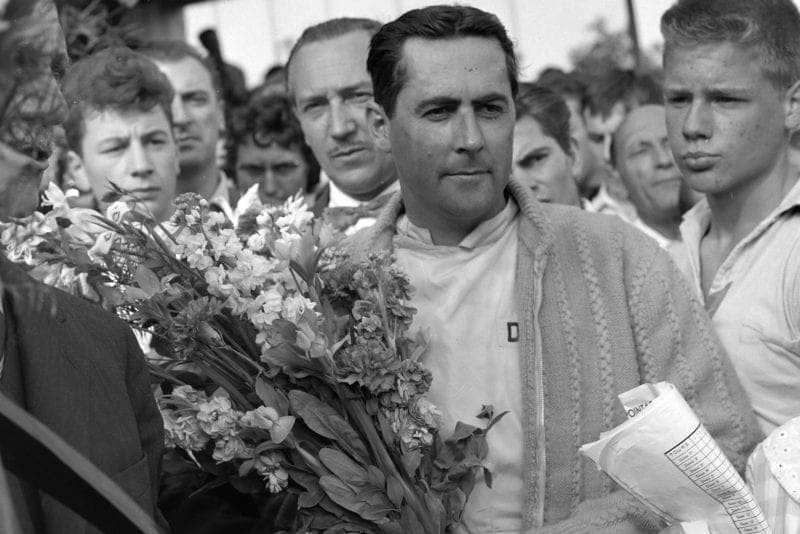
Brabham took victory by over a minute
Motorsport Images
On the previous lap Gendebien’s trouble was obviously getting worse for McLaren had taken 3rd place and now he went past the stationary BRM into 2nd place and a little while later Gendebien coasted down the hill to the pits with only 1st and 2nd speeds left in his gearbox and he stopped by the finishing line, ready to roll across when Brabham was flagged home the winner.
“Brabham completed his last lap to win the fastest race ever run at Spa”
Brabham completed his last lap to win the fastest race ever run at Spa, a race of incident and tragedy but one that he well deserved to win, having been in full control of the situation throughout the whole meeting. His young team-mate McLaren came home 2nd having driven a sensible race, well within his own capabilities and profiting from the mechanical failures of others.
Gendebien free-wheeled across the line to take 3rd place after having driven a truly splendid race, fighting all the way, and Phil Hill arrived 4th, deserving a far better placing but safe in the knowledge that Ferrari are still to be reckoned with when it comes to racing on the best Grand Prix circuits at real Grand Prix speeds. The Lotus of Jim Clark and the Cooper of Bianchi brought the total of finishes to a meagre six from the 17 starters, showing that once again the Belgian Grand Prix had lived up to its reputation of being one of the harder and more exacting Grand Prix events.
